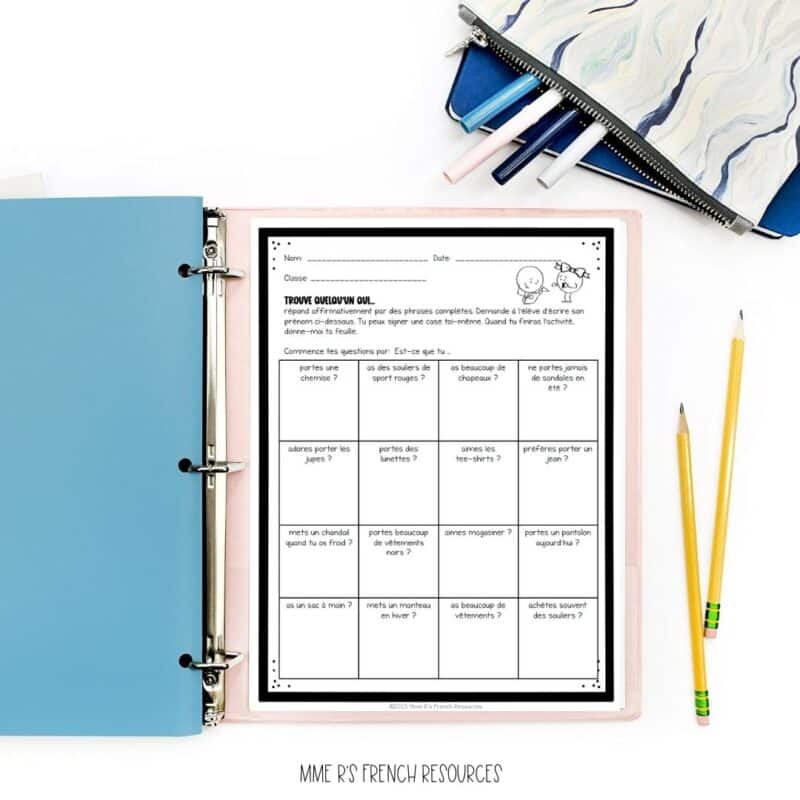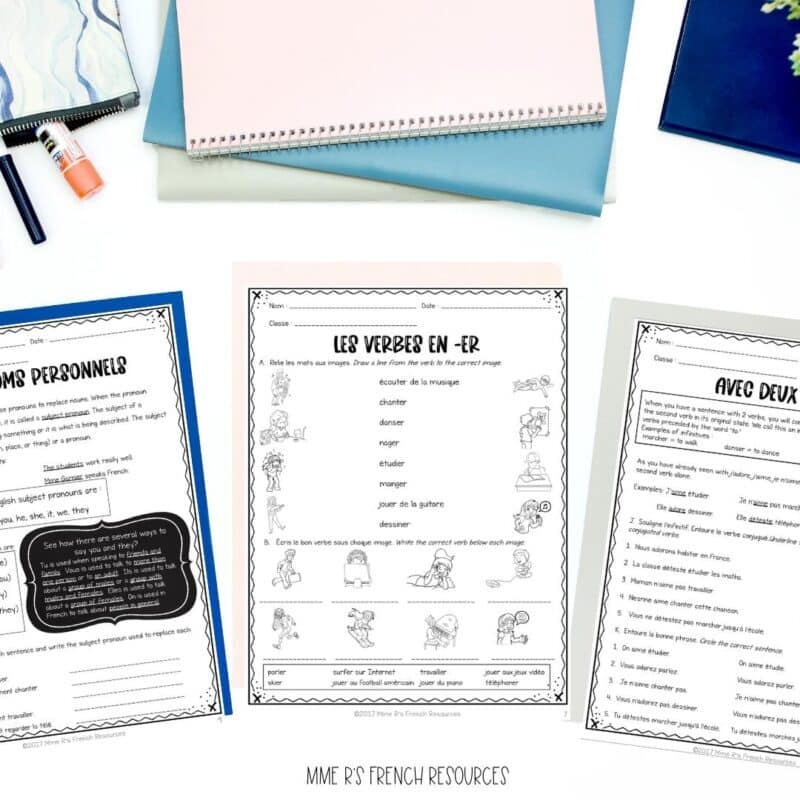es
Does your school use a block schedule? Maybe you’re a pro at it and you love it. Maybe you’re like me and you could use some block schedule teaching strategies for your French class.
Since I started teaching French in 2004, I’ve taught in schools with all types of schedules. Mostly, I’ve taught a schedule similar to what I grew up with – a standard 50 minute class, with seven periods a day. I have to say, this is by-far the easiest for me.
One year, I taught three 50 minute classes and one 90 minute block schedule class per week. I liked this okay, because one day a week with a longer class was ideal for projects or tests. I still saw students four days a week, so there weren’t big time gaps from one class to the next.
Yet another year, I taught a high school French 1 class for two 50 minute classes and a middle school French 1 block schedule class. This year was not only really hard, but it helped me see just how differently I had to structure the two groups.
Here’s what I figured out:
I spent way too much time teaching.
I know that might not make sense right away, but it’s true. I spent a lot of each class period teaching students new concepts. I was expecting them to get the information, understand it, then practice it at home. The next day, I’d teach a little more, they’d do more homework, and we’d keep moving on.
The problem was, I expected them to get most of their practice at home. They were good about doing their homework, so it had always worked. It wasn’t until I saw my block schedule students for 90 minutes and then didn’t see them again for days that it was a big issue.
I wasn’t planning enough activities.
We had what I thought was a pretty standard language class. I started them with bell-ringers. We checked them. We did a few quick minutes of vocabulary review. I taught some new grammar or added new vocabulary. We practiced a little, played a game, or did a speaking activity. At night, they did homework. Most days repeated like that. I knew exactly how long things took, and I very rarely had leftover class time.
With a block schedule, that all changed! I either never got through all the material because students weren’t ready to move on in the next class period, or I had underplanned and suddenly I had twenty minutes to spare.
I constantly had to reassess where I was in my pacing.
Because I taught the same class at a middle school and a high school, I had not only very different students, but different school schedules. My high schoolers had a 50 minute class five times a week. My middle schoolers had a 90 minute block schedule class every other day. This meant some weeks I would only see them twice!
By winter break, my middle school was several weeks behind. Part of the issue was that I missed more classes for things like assemblies or field trips. The other problem was that they would arrive in class on a Monday, and having not been in my class since Thursday of the previous week (or earlier sometimes), they hadn’t yet mastered the material. I had to slow down, reteach, and redo my plans over and over.
Over winter break, I had to really reassess what I was doing, because I was on track to end up teaching nearly 20% less in my middle school block schedule class! We had a 10 unit program, so that meant not even looking at units nine and ten.
Here’s what I did that helped my block schedule stay on track.
I cut out some material.
Sadly, that was the first thing to go. I had to keep them on the same pace as my high schoolers, because they were all going to start the next year together in French 2. Not doing the last two units would have meant they were missing a lot of very common beginner verbs and vocabulary!
Instead of just trying to fit it all in, I redefined what the absolute musts were. They had to know certain vocabulary and verbs to be successful in French 2. They needed to be able to structure sentences. They needed to be able to understand basic written and spoken directions. I decided which things could wait for another year, and I moved them to French 2 – or I did them with my high schoolers and gave them middle schoolers some time to catch up.
I planned way more in-class activities.
In a typical high school class, I’d have taught multiple lessons in one week. To keep the same pace in my middle school, that would mean two lessons per day sometimes. This was WAY too much.
Rather than worry about “covering” so much material, I made sure they got solid practice with the material I had on my must-do list. I could still teach a lesson, but we might play a game of Scoot to practice. Not only is it way more fun than a worksheet, movement is even more important when kids spend extended periods of time in the same classes with a block schedule.
The extra practice actually allowed me to go so much deeper, so even if they were exposed to less material, they understood the core concepts as well as my high schoolers did.
Fun activities like this French write the room activity are a great way for students to create their own vocabulary lists and get in some much-needed movement while breaking up the class time so students stay engaged.
I got them speaking a LOT more.
My middle schoolers didn’t have as large a range of vocabulary as my high schoolers that year, but they became really good speakers! Because the block schedule classes were so much longer, I aimed to have a good portion speaking activities for each week. We weren’t rushed, it felt like a brain break for them, and it was still really productive.
They need a lot of practice, and the more variety I was able to add, the better they did. Plus, because they were using important language skills for the entire block, the block schedule class actually scored as well as the high schoolers on the end of unit assessments.

This French speaking activity is great to provide movement and get students speaking with simple prompts that will help even the most-nervous speakers feel comfortable. You can follow it up with the included option to turn it into a speaking assessment, too!
I gave myself and my students a lot of grace.
I realized that the block schedule was just going to be harder for me – and for some of them. I let them know it was new for me, and I asked them what they liked to do in class. They were more experts at it than I was, because it was their third year with blocked classes. I asked them for a lot of feedback and I adjusted my plans based on their needs.
I also was way more lenient on late work, because it was just a lot harder for some of them to stay on top of it with fewer classes per week.
I changed my homework expectations.
I used to give nightly homework so that students would practice the concepts that I had just taught. Because I was only seeing students 2-3 times a week at most, this meant either longer homework or just plain doing a little less. Neither one worked out well, so I came up with a new plan that forever changed how I assigned homework.
I started making student packets that students would have 1-2 weeks to work on. The packets had notes over what I had taught, practice activities, plus some enrichment.

These French ER verbs worksheets include so many different pages to choose from that it’s easy to provide differentiation or student choice! With speaking activities, exit tickets, and quizzes, it includes everything you need for a French ER verbs unit.
I would assign a set number of activities for a range of pages in the packet, and students could pick the ones they liked. I’d periodically check them for progress and leave a little class time for questions, but the expectation was that they would practice what they liked when they had time. I didn’t use class time for this practice, but I did build in a little time in to one of my block schedule classes answer questions each week.
They liked it a lot more, because they weren’t stressed about long assignments after school. They could wait for another class period if they didn’t understand, and they loved getting to pick their activities.
Here are some block schedule teaching strategies that worked for me:
Take time to just chat.
It’s that simple. In a 50 minute class, you’re in a rush to get started, take attendance, teach a lesson, practice, pass out homework, and get ready for the next class. With a longer block schedule class, you can spend a little time chatting. Maybe you tell them a story about what happened while you were driving to work. Maybe you do a turn and talk time with their neighbors. Whatever you do, you’ve got some time to talk! Put it to good use.
Plan for 5 or 6 activities in a block schedule class period.
Really! You can change it up every 15-20 minutes and get in a TON of meaningful practice. Plus, it will make that time go by SO much faster for everyone! It’s okay if you don’t get it all done. It’s better to overplan than have time spent doing nothing.
You might have something like this:
- Bell-ringers (10 minutes)
- Chat time (10 minutes)
- Direct instruction (10-15 minutes)
- Game (20 minutes)
- Structured speaking or reading activity (20 minutes)
- Writing time (15 minutes)
- Wrap up lesson, exit ticket, answer questions, etc.
Have some music videos or conversation cards on hand in case you do end up with some extra time.
Always plan to have something for students to do if you don’t use the whole class period. It doesn’t have to be a structured activity, but having a song or video related to your unit or pulling out a few conversation cards can be a big help!
Find more ideas for making the most of leftover class time HERE.
I hope some of these block schedule teaching strategies are helpful!



Raija Chapman says
This is such useful advice, I really can see how I can adopt so many of these strategies, thankyou! I notice that the link to the ‘student packets’ isn’t working – the TPT store doesn’t list any items – I’d love to see an example of how you set out your student packets, as this idea of having them complete work (with choice involved) is definitely one I want to incorporate. Having long spaces between lessons is a nightmare, but this article really has helped me see some solutions!
Ashley says
Hi there! I’m so glad it’s helpful! I’m not sure why the link isn’t opening for you, because it worked for me. You can find them here:
https://www.teacherspayteachers.com/Store/Mme-Rs-French-Resources/Category/10028Grammar-and-vocabulary-packets-300114
Raija Chapman says
I also meant to ask: is the ‘chat time’ intended to be done in French or in English? I’m sorry if it’s a silly question!
Ashley says
Chat time is usually in French. If I have a culture lesson I’m doing with beginners who don’t have much proficiency, we might do something in English with partners. Then, I’d ask them to share a bit about what they discussed and we’d create a short list of new French words for their notebooks. 🙂